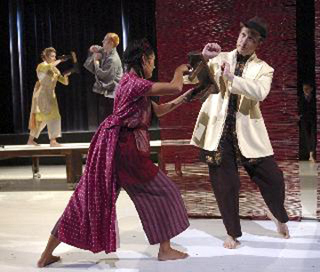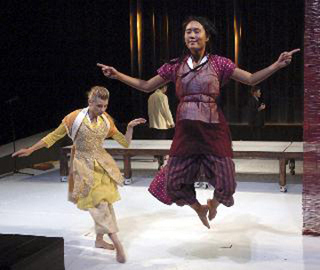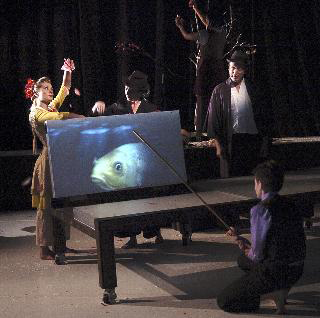Cross-Cultural Explorations
"Baggage Across the East-West Divide"
"The Other Here"
Big Dance Theater
Dance Theatre, Clarice Smith Performing Arts Center at Maryland
College Park, MD
Thursday, September 28, 2006
by Lisa Traiger
copyright ©2006 by Lisa Traiger
 A century ago, the West gazed eastward besotted of all things Oriental. Décor, fabrics, spices, fashion, painting, calligraphy, music and dance from then-far-off lands enchanted Americans and Europeans, who invited brocades and umbrellas, quickening brush strokes and new scents and flavors into their lives as they left the Victorian era behind. Today our Western regard of the East is of an entirely different sort, rife as it is with politics, diplomatic interchange, trade imbalances and continued misunderstandings of cultural distinctions.
A century ago, the West gazed eastward besotted of all things Oriental. Décor, fabrics, spices, fashion, painting, calligraphy, music and dance from then-far-off lands enchanted Americans and Europeans, who invited brocades and umbrellas, quickening brush strokes and new scents and flavors into their lives as they left the Victorian era behind. Today our Western regard of the East is of an entirely different sort, rife as it is with politics, diplomatic interchange, trade imbalances and continued misunderstandings of cultural distinctions.
“The Other Here” is another Big Dance Theater cultural mashup, positing a contemporary way of looking East and borrowing for the West. The company, co-directed by choreographer Annie-B Parson and director Paul Lazar, brought “Shunkin,” which blended rock and roll with kimonos and kabuki to retell Japanese novelist Junichiro Tanizaki’s tale of a blind musician, to College Park in 2003. Again using Asian literary inspiration, this time a pair of short stories by 20th-century Japanese writer Masuji Ibuse, conjoined with the uber-persuasive motivational speeches from the Million Dollar Round Table, a high-powered global network of top-notch life insurance salespeople, Parson and Lazar re-imagine Japan in their own image. They’re cultural tourists in a global marketplace where intermingling breeds unexpected and discursive ideas, or as Parson quotes Salmon Rushdie in the director’s notes: “It rejoices in mongrelizaton and fears absolutism of the pure.”
Mehdi, a pale-faced, bedraggled Lazar, sells life insurance, but doesn’t seem very successful, in his droopy fedora and loose-fitting kimono. He spends much of his time castigating his lazy servant, Yosuji, an unrepentant pipe-smoking Molly Hickock in a tweed jacket and loose-fitting Japanese pants. This narrative stream gives way to Jess Barbagallo’s microphone-wielding emcee, who interrupts with slick instructions on persuading buyers to give in to sales pitches. Attractively boyish and exceedingly confident, Barbagallo inhabits the character of a slick pitchman with finesse, lowering his voice to a conspiratorial whisper when about to go in for the hard sell, or modulating his pitch like a charismatic Baptist preacher when the crowd needs a touch more push. Babagallo, in sharkskin black suit and bare feet, suggests how closely related motivational speakers and men of god really are, cut as they are from the same cloth.
 Interspersed in this unexpected admixture of narrative threads, Parson bastes the stage with robustly performed Okinawan folk dances and kitschy but charming Okinawan pop ballads. But these are not culturally accurate renderings of ancient and powerful tribal dances. Rather they’re rough-hewn smatterings of boisterous hops, bent elbows and cocked wrists, that the dancers culled from lessons with an expert. Sped up about four-score from the painstaking traditional tempo, it feels naïve, formal, yet with a hint of gracelessness in its claps, stomps and stiffened bodies. And when Heather Christian belts out those heartfelt pop ballads with her escalating tremolo and phonetically sung syllables, there’s a recognizable sense of longing and heartbreak, just like the teenagey angst ballads we’ve all grown up with.
Interspersed in this unexpected admixture of narrative threads, Parson bastes the stage with robustly performed Okinawan folk dances and kitschy but charming Okinawan pop ballads. But these are not culturally accurate renderings of ancient and powerful tribal dances. Rather they’re rough-hewn smatterings of boisterous hops, bent elbows and cocked wrists, that the dancers culled from lessons with an expert. Sped up about four-score from the painstaking traditional tempo, it feels naïve, formal, yet with a hint of gracelessness in its claps, stomps and stiffened bodies. And when Heather Christian belts out those heartfelt pop ballads with her escalating tremolo and phonetically sung syllables, there’s a recognizable sense of longing and heartbreak, just like the teenagey angst ballads we’ve all grown up with.
Videographer Peter Flaherty’s projections, specifically lush footage of a koi carried in a wooden box, proved magical in adding natural and realistic touches to a fairly conceptual setting. Takeshi Kata’s design features a series of burlap panels that scroll and unscroll like window shades, and an oversized low table on casters that serves as bed, stage, house, garden and more. Simple yet used exceedingly well in delineating spaces in the ever shifting landscape of the work, these elements, too, look both eastward and to the west, with hints of spare Japanese design put to contemporary use. Big Dance Theater often doesn’t mind showing the fundamental bones of a design, and here was no exception, as cherry blossom branches were tucked into microphone stands and visible fans allowed for rain to fall in oversized white paper drops.
 “The Other Here” is a slippery work, both captivating and confounding. There’s beauty in the imagery and in the loose, but never overly casual manner in which they performed the dances. And there’s beauty, too, in the simple design strokes — the placement of a bench, a table, a branch that make the settings natural and somehow even realistic. And in the way these oddly selected texts somehow mesh by evening’s end. The performers, Lazar, Hickok, Barbagallo, and Christian, joined by sweet and shimmery Jennie Mary Tai Liu and sturdy Chris Giarmo, have a compelling and understated way of inhabiting this East-West blend that never veers far into parody, before returning with respect, if not reverence for a culture that will, Parson suggests, remain ever foreign.
“The Other Here” is a slippery work, both captivating and confounding. There’s beauty in the imagery and in the loose, but never overly casual manner in which they performed the dances. And there’s beauty, too, in the simple design strokes — the placement of a bench, a table, a branch that make the settings natural and somehow even realistic. And in the way these oddly selected texts somehow mesh by evening’s end. The performers, Lazar, Hickok, Barbagallo, and Christian, joined by sweet and shimmery Jennie Mary Tai Liu and sturdy Chris Giarmo, have a compelling and understated way of inhabiting this East-West blend that never veers far into parody, before returning with respect, if not reverence for a culture that will, Parson suggests, remain ever foreign.
So the question becomes, what is that worrisome issue gnawing in the subconscious? When is it okay to appropriate another’s the cultural product, when is it respectful and went is it not? The dancers took time to study authentic Okinawan dance, but realized that in even two years time they could never hope to attain the depth of performance and quality of expression true Okinawans have. So instead, Big Dance’s collaborators chose to perform the same steps and poses with a Western regard, sped up, with gusto ad force. Is it no different then when I travel to Morocco and pick out a perfect rug that I bring home to place in my suburban Maryland home, instead of in an authentic Moroccan abode? When are we cultural borrowers, inspired and when are we cultural appropriators, stealing another’s art, music and dance? And why are we always fearful of wrong interpretations and misuses of cultural output? This same weekend I was fortunate to catch a revival of Ruth St. Denis’s 1906 solo “The Incense,” at “The Art of the Solo” program at the Baltimore Museum of Art. A century ago, exactly, Miss Ruth was roused by an advertisement for Egyptian Deities cigarettes and she went East to find inspiration. A hundred years later, we’re still looking East, and we remain cultural tourists, curious as ever about the other. Big Dance Theater seems to suggest that we’re also cultural producers, thrust into an ever-shifting and dynamic new world where ideas are purveyed in seconds and creative output on the global stage is a cultural stew that borrows its ingredient from a mongrelized world where borders matter less than ideas about how to cross and permeate them.
Photos, all by Stan Brouh, all from Big Dance Theater's "The Other Here," from top:
Background L to R: Heather Christian and Chris Giarmo; foreground L to R: Jennie Mary Tai Liu and Molly Hickok.
From L to R: Heather Christian and Jennie Mary Tai Liu.
From L to R: Heather Christian, Molly Hickok, Paul Lazar (co-artistic director), and Jess Barbagallo (kneeling).
Volume 4, No. 35
October 2, 2006
copyright ©2006 Lisa Traiger
www.danceviewtimes.com